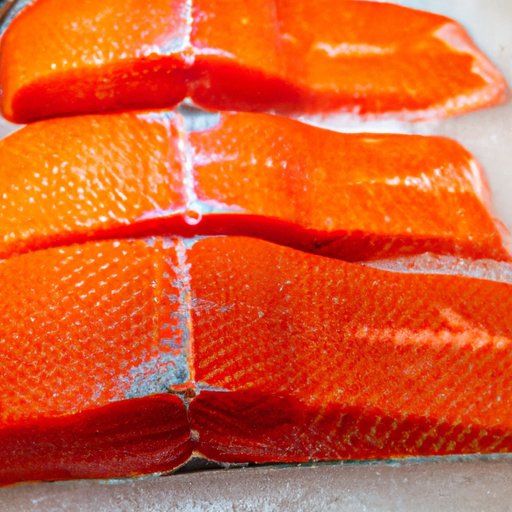
Introduction
Salmon is a popular and delicious fish that is high in protein and rich in omega-3 fatty acids. However, fresh salmon can be expensive, and it is not always convenient to purchase it all the time. Freezing salmon is a great way to save money, reduce waste, and have a supply of fish readily available whenever you need it. However, improper freezing can cause freezer burn and spoilage, so it is important to know how to do it properly.
Top 5 Tips for Freezing Salmon
Using Fresh Salmon
When freezing salmon, always use fresh fish. Fresh fish will taste better and hold up better in the freezer than frozen fish. If you cannot get fresh fish, frozen fish is an acceptable alternative.
Choosing the Right Packaging
The right packaging can make a big difference in how well salmon freezes. Vacuum-sealed bags are the best choice, but if you don’t have them available, use a heavy-duty freezer bag with a double seal.
Removing Excess Air
Excess air in the packaging can cause freezer burn. To avoid this, press as much air out as possible before sealing the packaging.
Labeling and Dating
Always label and date the packaging before placing it in the freezer. This will help you keep track of how long the salmon has been frozen and avoid confusion.
Freezing Salmon Individually
Freezing salmon individually prevents it from sticking together and makes it easier to thaw the amount you need. Place each piece of salmon in the packaging separately and freeze it flat.
A Step-by-Step Guide for Freezing Salmon
Cleaning and Preparing the Salmon
Start by cleaning and preparing the salmon. Remove the scales, head, tail, and entrails, and rinse the fish in cold water. Place the salmon on a cutting board, and cut it into portions of your choice.
Wrapping the Salmon
Place each portion of salmon into a vacuum-sealed bag or heavy-duty freezer bag with a double seal. Press out as much air as possible before sealing the bag. Label and date the packaging.
Placing the Salmon in the Freezer
Place the packaged salmon in the freezer, making sure it does not touch anything else until it is frozen solid. Do not overcrowd the freezer or stack the salmon packages until they are frozen solid.
Ensuring Even Freezing
For even freezing, it is important that the freezer is at its coldest temperature (-18°C or 0°F). If your freezer has a fast-freeze feature, use it to lower the temperature quickly. Also, leave enough space around each package to allow for proper air circulation.
How to Avoid Freezer Burn When Freezing Salmon
Causes of Freezer Burn
Freezer burn occurs when food is not correctly stored in the freezer. Light, heat, and air can cause freezer burn, which dehydrates the fish and causes it to lose both its taste and texture.
Preventions of Freezer Burn
To avoid freezer burn, make sure the salmon is wrapped tightly in its packaging. Using freezer bags with an airtight seal, vacuum-sealed bags, or heavy-duty aluminum foil will help protect the fish from air. Also, store food in the coldest part of the freezer to avoid thawing and refreezing.
Identifying Freezer Burn
Freezer burn is easy to recognize. Look for discolored or dry spots on the fish, and ice crystals on the surface. If the salmon has a strange smell or flavor, it is likely freezer-burnt.
Salvaging Freezer-Burnt Salmon
If the salmon is freezer-burnt, it is still safe to eat, but it will not taste as good. Trim off the freezer-burnt areas before cooking it.
Understanding How Long the Freezer Can Preserve Salmon and the Best Way to Thaw It
How Long Salmon Can Be Frozen
Salmon can be frozen for up to six months without losing its flavor and texture. However, it’s best to consume it within the first three months for optimal taste.
Differences in Freezing Times for Different Kinds of Salmon
The freezing time can vary depending on the type of salmon. Wild salmon freezes a lot faster than farmed salmon. It’s essential to know the variety of salmon you have before freezing it and follow its recommended freezing time.
Proper Thawing Methods
Thawing salmon in the refrigerator is the best option. Remove the salmon from the freezer and place it in the fridge overnight to thaw completely. If you need to thaw it quickly, place the unopened vacuum-sealed bag or heavy-duty freezer bag in a bowl of cold water for a few hours.
What to Avoid When Thawing Salmon
Never thaw salmon at room temperature or use hot water to thaw it. Doing so will raise the temperature too quickly and encourage bacterial growth. Avoid thawing salmon in the microwave unless you’re going to cook the salmon immediately.
Tips on How to Store Leftover Salmon in the Freezer and Use It in Delicious Recipes Later On
Storing Cooked Salmon
Cooked salmon can be stored in the freezer for up to six months. Make sure it is wrapped correctly to avoid freezer burn. Individual portions in a vacuum-sealed bag or heavy-duty freezer bag with a double seal work best.
Storing Raw Salmon
Raw salmon can be stored in the freezer for up to six months. Follow the same guidelines as freezing fresh salmon.
Ideas for Leftover Salmon Recipes
Leftover salmon can be used in a wide variety of recipes, including salmon burgers, salads, pasta, and fish cakes. Its versatility makes it perfect for any meal.
Conclusion
Freezing salmon is an excellent way to save money, reduce waste, and have a constant supply of fish on hand. By following these tips and step-by-step guide, you can freeze salmon properly and avoid freezer burn. Knowing how long salmon can be frozen and how to thaw it correctly will help you enjoy its taste and texture. So, don’t hesitate, give it a try, and enjoy your favorite fish all year long.





